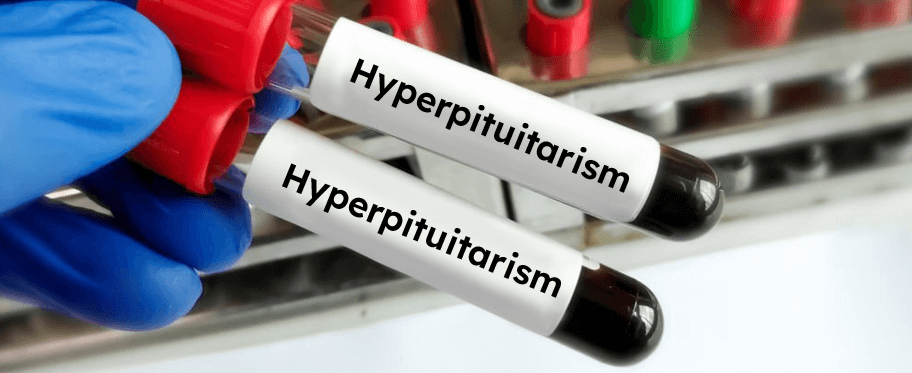
Hyperpituitarism and Fertility
Having an overactive pituitary gland is called hyperpituitarism. Tumors usually cause this condition by making the gland produce too much or too little of the hormones that control growth, reproduction and metabolism. The hormonal changes cause a range of different disorders, from gigantism in children to hyperthyroidism in adults.
What is hyperpituitarism (overactive pituitary gland)?
When your pituitary gland is overactive, it releases excessive amounts of certain types of pituitary hormones into your bloodstream. A tumor in the gland, called a pituitary adenoma, is usually the cause of this condition. An overactive pituitary gland can cause a variety of disorders that affect growth, metabolism, reproduction and other vital body functions.
What does the pituitary gland do?
The pituitary gland plays a major role in controlling how your body works. It’s a pea-sized, cherry-shaped endocrine gland located near the base of your brain. Endocrine glands release (secrete) hormones into your bloodstream that control your body’s functions. Your endocrine system affects almost every cell and organ in your body. Sometimes the pituitary is called the “master gland” because it controls the activity of other endocrine glands. Most importantly, it controls the activity of your thyroid gland, adrenal gland and gonadal glands (ovaries or testes).
Think of your pituitary gland like a thermostat. The thermostat performs constant temperature checks in your home to keep you comfortable. It sends signals to your heating and cooling systems to turn up or down — and by how many degrees — to keep air temperatures constant. Your pituitary gland monitors your body functions in much the same way. Your pituitary gland sends signals to your organs and glands to tell them what functions are needed and when. The right settings for your body depend upon many things, including your sex, weight distribution and how active you are.
Blood vessels connect your pituitary gland to a part of your brain called the hypothalamus. Your brain tells your pituitary gland to increase or decrease the secretion of certain hormones.
Your pituitary gland consists of three parts: the anterior, intermediate and posterior lobes.
How common are hyperpituitarism (overactive pituitary gland) disorders?
Depending on the disorder, some are more common than others. Some of the most common conditions are:
- Small benign pituitary tumors (adenomas): These are fairly common. About 10,000 are diagnosed in the U.S. each year. They may secrete excess amounts of hormones or be nonsecreting and not cause any symptoms.
- Prolactinomas: Prolactinomas are the most common type of pituitary tumors, occurring in about 1 out of every 10,000 people. They’re more common in people assigned female at birth than people assigned male at birth.
- Cushing’s syndrome: Cushing’s syndrome is a relatively rare disorder that occurs mainly in adults between the ages of 20 and 50 years old.
- Acromegaly: Acromegaly is a rare disorder that occurs in only about 3 out of every 1 million people each year. It’s generally diagnosed in adults between the ages of 40 and 45.
Hyperpituitarism in children
Hyperpituitarism is rare in children. If it does occur, it typically results from pituitary microadenoma, a small (less than 10 millimeters), benign tumor. The most common pituitary adenoma found in childhood are prolactinomas, which occur in approximately half of all cases. Prolactinomas originate from stem cells of hormone-producing glands, which explains why they may secrete hormones. Several inherited syndromes — including multiple endocrine neoplasia type 1 (MEN1), Carney complex and familial isolated pituitary adenomas — appear to cause prolactinomas.
The disorders caused by prolactinomas depend on the sex and age of the child:
- Children assigned female at birth may experience delays in puberty, loss of monthly periods (amenorrhea) and other symptoms of hypogonadism (failure of the ovaries to function properly). They produce less estrogen.
- Children assigned male at birth are more prone to macroprolactinomas (large prolactinomas). Due to the size of macroprolactinomas, they tend to cause mass effect. This means the tumor presses on nerves and causes more neurological and ophthalmological issues (cranial nerve compression, headaches and vision loss). They can also experience puberty delays or growth issues.
TREATMENT FOR HYPERPITUITARISM
Tumors affecting the pituitary gland are usually noncancerous, and they can be treated, although some are difficult to treat. Some types of tumors continue to recur despite treatment. In most cases involving fertility problems, medications are prescribed to help restore normal hormone levels and shrink the size of a prolactinoma.
Tests are necessary in order to make an accurate diagnosis. Testing includes measurement of prolactin levels in the blood. An underactive thyroid, also called hypothyroidism, can also cause elevated prolactin levels. Tests can determine if the higher levels of prolactin are caused by hyperpituitarism or hypothyroidism. Once a diagnosis has been made, your doctor will recommend treatment options.
Infertility can cause heartbreak for those families hoping to build their families. Chawla Nursing Home can help you overcome the obstacles with highly skilled fertility doctors and state-of-the-art technology. Contact our office, and schedule an appointment for more information about how we can help you achieve your dreams of starting your family.
Schedule An Appointment
Get your Appointment Confirm with us Easily

